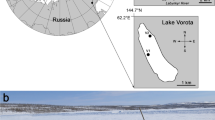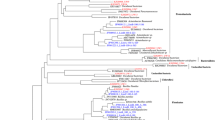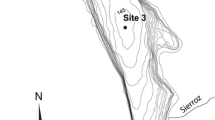Abstract
Vertical profiles of microbial assemblages from samples of Mono Lake water collected in July 1994 and in April and July 1995 were obtained by analyzing DNA via the polymerase chain reaction (PCR) and denaturing gradient gel electrophoresis (DGGE) of 16S ribosomal RNA (rRNA) genes. The microbial assemblage was vertically stratified and distributions of individual ribotypes were coherent with temperature, salinity, irradiance and dissolved oxygen distributions at the beginning of the study in July of 1994. The lake mixed completely during the winter of 1994–1995 and was beginning to stratify thermally by April 1995. Water column gradients were weak and oxygen was depleted at depth. The microbial assemblage was uniformly distributed throughout the water column except at 20 m, where one band dominated. The microbial assemblage was vertically stratified again by July 1995. Partial sequences (134–160 bp, except one of 83 bp) obtained from DGGE bands revealed affinities to known organisms, but only one potentially exact match was found. With a few exceptions, the same ribotypes were present on all sampling dates; there was no evidence for a marked seasonal succession in microbial community composition, despite the dramatic changes in limnological conditions that accompanied the winter overturn. A band that was ubiquitous in samples from the oxycline and hypolimnion in July of both years was found throughout the water column in April. This sequence could be attributed to the chloroplast rRNA gene of an unusual phytoplankter, the green alga Picocystis salinarum.
Similar content being viewed by others
References
Altschul, S. F., W. Gish, W. Miller, E. W. Myers & D. J. Lipman, 1990. Basic local alignment search tool. J. mol. Biol. 215: 403–410.
Andersen, R. A., G. W. Saunders, M. P. Paskind & J. P. Sexton, 1993. Ultrastructure and 18S rRNA gene sequence for Pelagomonas calceolata gen. et sp. nov. and the description of a new algal class, the Pelagophyceae classis nov. J. Phycol. 29: 701–715.
Anderson, R. F., M. P. Bacon & P. G. Brewer, 1982. Elevated concentrations of actinides in Mono Lake. Science 216: 514–516.
Benson, L. V., J. W. Burdett, M. Kashgarian, S. P. Lund, F. M. Phillips & R. O. Rye, 1996. Climatic and hydrologic oscillations in the Owens Lake Basin and adjacent Sierra Nevada, California. Science 274: 746–749.
Benson, L. V., S. P. Lund, J. W. Burdett, M. Kashgarian, T. P. Rose, J. P. Smoot & M. Schwartz, 1998. Correlation of late-Pleistocene lake-level oscillations in Mono Lake, California, with North Atlantic climate events. Quat. Res. 49: 1–10.
Brosius, J., M. L. Palmer, J. K. Poindexter & H. F. Noller, 1978. Complete nucleotide sequence of a 16S ribosomal RNA gene from Escherichia coli. Proc. natl. Acad. Sci. U.S.A. 75: 4801–4805.
Christen, M. N., C. M. Gilbert, K. R. Lajoie & Y. Alrawi, 1969. Geological-geophysical interpretation of Mono Basin, California-Nevada. J. geophys. Res. 74: 5221–5337.
Cloern, J. E., B. E. Cole & R. S. Oremland, 1983a. Autotrophic processes in meromictic Big Soda Lake, Nevada. Limnol. Oceanogr. 28: 1049–1061.
Cloern, J. E., B. E. Cole & R. S. Oremland, 1983b. Seasonal changes in the chemistry and biology of a meromictic lake (Big Soda Lake, Nevada, U.S.A.). Hydrobiologia 105: 195–206.
Dana, G. L. & P. H. Lenz, 1986. Effects of increasing salinity on an Artemia population from Mono Lake, California. Oecologia 68: 428–436.
DeAngelis, M.M., D. G. Wang & T. L. Hawkins, 1995. Solid-phase reversible immobilization for the isolation of PCR products. Nucleic Acids Res. 23: 4742–4743.
Diaz, M. R. & B. F. Taylor, 1996. Metabolism of methylated osmolytes by aerobic bacteria from Mono Lake, a moderately hypersaline, alkaline environment. FEMS Microbiol. Ecol. 19: 239–247.
Domagalski, J. L., W. H. Orem & H. P. Eugster, 1989. Organic geochemistry and brine composition in Great Salt, Mono, and Walker Lakes. Geochim. cosmochim. Acta 53: 2857–2872.
Duckworth, A.W., W. D. Grant, B. E. Jones & R. Van Steenbergen, 1996. Phylogenetic diversity of soda lake alkaliphiles. FEMS Microbiol. Ecol. 19: 181–191.
Felsenstein, J., 1993. PHYLIP (Phylogeny Inference Package). Version 3.5c. University of Washington, Seattle.
Ferrari, V. C. & J. T. Hollibaugh, 1999. Distribution of microbial assemblages in the Central Arctic Ocean Basin studied by PCR/DGGE: analysis of a large data set. Hydrobiologia 401: 55–68.
Grant, W. D., 1998. Halophiles. In Horikoshi, K. & W. D. Grant (eds), Extremophiles: Microbial Life in Extreme Environments. Wiley-Liss, New York: 93–132.
Grant, W. D., W. E. Mwatha & B. E. Jones, 1990. Alkaliphiles – ecology, diversity and applications. FEMS Microbiol. Rev. 75: 255–269.
Hollibaugh, J. T., J. Pages, J.-P. Torreton & P. S. Wong, 1999. Phylogenetic variation in bacterial populations from 10 atoll lagoons in the Tuamotu Islands, French Polynesia. In Brylinsky, M. J. (ed.), Trends in Microbial Ecology. Proceedings of the Eighth International Symposium on Microbial Ecology; Halifax, Nova Scotia, Canada, 9-14 August, 1998: 231–235.
Hollibaugh, J. T., P. S. Wong & M. C. Murrell, 2000. Similarity of particle-associated and free-living bacterial communities in northern San Francisco Bay, California. Aquatic microb. Ecol. 21: 103–114.
Horikoshi, K. & T. Akiba, 1982. Alkalophilic Microorganisms. Springer-Verlag, Berlin: 213 pp.
Jellison, R. & J. M. Melack, 1988. Photosynthetic activity of phytoplankton and its relation to environmental factors in hypersaline Mono Lake, California. Hydrobiologia 158: 69–88.
Jellison, R. & J. M. Melack, 1993a. Algal photosynthetic activity and its response to meromixis in hypersaline Mono Lake, California. Limnol. Oceanogr. 38: 818–837.
Jellison, R. & J.M. Melack, 1993b. Meromixis in hypersaline Mono Lake, California. 1. Stratification and vertical mixing during the onset, persistence, and breakdown of meromixis. Limnol. Oceanogr. 38: 1008–1019.
Jellison, R., R. F. Anderson, J. M. Melack & D. Heil, 1996. Organic matter accumulation in sediments of hypersaline Mono Lake during a period of changing salinity. Limnol. Oceanogr. 41: 1539–1544.
Jellison, R., J. Romero & J. M. Melack, 1998. The onset of meromixis during restoration of Mono Lake, California: unintended consequences of reducing water diversions. Limnol. Oceanogr. 43: 706–711.
Johannesson, K. H. & W. B. Lyons, 1994. The rare earth element geochemistry of Mono Lake water and the importance of carbonate complexing. Limnol. Oceanogr. 39: 1141–1154.
Joye, S. B., T. L. Connell, L. G. Miller, R. S. Oremland & R. S. Jellison, 1999. Oxidation of ammonia and methane in an alkaline, saline lake. Limnol. Oceanogr. 44: 178–188.
Lenz, P. H., S. D. Cooper, J. M. Melack & D. W. Winkler, 1986. Spatial and temporal distribution patterns of three trophic levels in a saline lake. J. Plankton Res. 8: 1051–1064.
Lewin, R. A., L. Krienitz, R. Goericke, H. Takeda & D. Hepperle, 2000. Picocystis salinarum gen. et sp. nov. (Chlorophyta) – a new picoplanktonic green alga. Phycologia. 39: 560–565.
Li, L., C. Kato & K. Horikoshi, 1999. Microbial diversity in sediments collected from the deepest cold-seep area, the Japan Trench. Mar. Biotechnol. 1: 391–400.
Maest, A. S., S. P. Pasilis, L. G. Miller & D. K. Nordstrom, 1992. Redox geochemistry of arsenic and iron in Mono Lake, California. In Kharaka, Y. K. & A. S. Maest (eds), Water- Rock Interaction. A. A. Balkema, Rotterdam, The Netherlands: 507–511.
Melack, J. M. & R. Jellison, 1998. Limnological conditions in Mono Lake: contrasting monomixis and meromixis in the 1990s. Hydrobiologia 384: 21–39.
Miller, L. G., R. Jellison, R. S. Oremland & C. W. Culbertson, 1993. Meromixis in hypersaline Mono Lake, California. 3. Biogeochemical response to stratification and overturn. Limnol. Oceanogr. 38: 1040–1051.
Murray, A. E., 1994. Community fingerprint analysis: a molecular method for studying marine bacterioplankton diversity. M.A. Thesis, Department of Biology, San Francisco State University, San Francisco, California: 128 pp.
Murray, A. E., J. T. Hollibaugh & C. Orrego, 1996. Phylogenetic compositions of bacterioplankton from two California estuaries compared by denaturing gradient gel electrophoresis of 16S rDNA fragments. Appl. envir. Microbiol. 62: 2676–2680.
Muyzer, G., E. C. de Waal & A. G. Uitterlinden, 1993. Profiling of complex microbial populations by denaturing gradient gel electrophoresis analysis of polymerase chain reaction-amplified genes coding for 16S rRNA. Appl. envir. Microbiol. 59: 695–700.
Myers, R. M., S. G. Fischer, L. S. Lerman & T. Maniatis, 1985. Nearly all single base substitutions in DNA fragments joined to a GC-clamp can be detected by denaturing gradient gel electrophoresis. Nucleic Acids Res. 13: 3131–3145.
Myers, R. M., T. Maniatis & L. S. Lerman, 1987. Detection and localization of single base changes by denaturing gradient gel electrophoresis. Meth. Enzymol. 155: 501–527.
Oremland, R. S. & L. G. Miller, 1993. Biochemistry of natural gases in three alkaline, permanently stratified (meromictic) lakes. In Howell, D. G. (ed.), The Future of Energy Gases. U.S. Geological Survey, Menlo Park, California: 439–452.
Oren, A., 1999. Bioenergetic aspects of halophilism. Microbiol. mol. Biol. Rev. 63: 334–348.
Pelagos Corporation, 1987. A bathymetric and geologic survey of Mono Lake, California. Report prepared for Los Angeles Department of Water and Power. San Diego, California: 67 pp.
Roesler, C. S., C. W. Culbertson, S. M. Etheridge, R. Goericke, R. P. Kiene, L. G. Miller & R. S. Oremland, 2002. Distribution, production and ecophysiology of Picocystis strain ML in Mono Lake, California. Limnol. Oceanogr. (in press).
Saunders, G. W. & G. T. Kraft, 1994. Small-subunit rRNA gene sequences from representatives of selected families of the Gigartinales and Rhodymeniales (Rhodophyta). 1. Evidence for the Plocamiales ord. nov. Can. J. Bot. 72: 1250–1263.
Simpson, H. R., R. M. Trier, D. E. Hammond, A. Ege, L. Miller & J. M. Melack, 1980. Fallout plutonium in an alkaline, saline lake. Science 207: 1071–1073.
Sorokin, D. Iu., T. P. Turova, B. B. Kuznetsov, I. A. Briantseva & V. M. Gorlenko, 2000. Roseinatronobacter thiooxidans gen. nov., sp. nov., a new alkaliphilic aerobic bacteriochlorophyllalpha-containing bacteria from a soda lake. Mikrobiologiia 69: 89–97.
Stine, S., 1994. Extreme and persistent drought in California and Patagonia during mediaeval time. Nature 369: 546–549.
Tanner, M. A., C. L. Everett, W. J. Coleman, M. M. Yang & D. C. Youvan, 2000. Complex microbial consortia inhabiting hydrogen sulfide-rich black mud from marine coastal environments. Biotechnology et Alia 8: 1–16.
Ward, B. B., D. P. Martino, M. C. Diaz & S. B. Joye, 2000. Analysis of ammonia-oxidizing bacteria from hypersaline Mono Lake, California, on the basis of 16S rRNA sequences. Appl. envir. Microbiol. 66: 2873–2881.
Wu, S.-M., L. A. Blomberg & W.-Y. Chan, 1996. Recovery of unlabeled PCR product from polyacrylamide gel for sequencing. BioTechniques 21: 358–362.
Zehr, J. P., R.W. Harvey, R. S. Oremland, J. E. Cloern, L. H. George & J. L. Lane, 1987. Big Soda Lake (Nevada). 1. Pelagic bacterial heterotrophy and biomass. Limnol. Oceanogr. 32: 781–793.
Author information
Authors and Affiliations
Rights and permissions
About this article
Cite this article
Hollibaugh, J.T., Wong, P.S., Bano, N. et al. Stratification of microbial assemblages in Mono Lake, California, and response to a mixing event. Hydrobiologia 466, 45–60 (2001). https://doi.org/10.1023/A:1014505131859
Issue Date:
DOI: https://doi.org/10.1023/A:1014505131859




